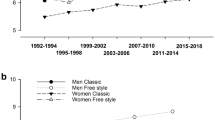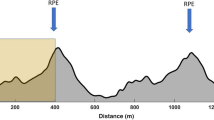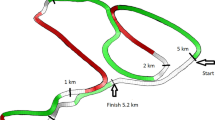Abstract
Speed skating is an intriguing sport to study from different perspectives due to the peculiar way of motion and the multiple determinants for performance. This review aimed to identify what is known on (long-track) speed skating, and which individual characteristics determine speed skating performance. A total of 49 studies were included. Based on a multidimensional performance model, person-related performance characteristics were categorized in anthropometrical, technical, physiological, tactical, and psychological characteristics. Literature was found on anthropometry, technique, physiology, and tactics. However, psychological studies were clearly under-represented. In particular, the role of self-regulation might deserve more attention to further understand mechanisms relevant for optimal performance and for instance pacing. Another remarkable finding was that the technically/biomechanically favourable crouched skating technique (i.e. small knee and trunk angle) leads to a physiological disadvantage: a smaller knee angle may increase the deoxygenation of the working muscles. This is an important underlying aspect for the pacing tactics in speed skating. Elite speed skaters need to find the optimal balance between obtaining a fast start and preventing negative technical adaptations later on in the race by distributing their available energy over the race in an optimal way. More research is required to gain more insight into how this impacts on the processes of fatigue and coordination during speed skating races. This can lead to a better understanding on how elite speed skaters can maintain the optimal technical characteristics throughout the entire race, and how they can adapt their pacing to optimize all identified aspects that determine performance.


Similar content being viewed by others
References
Muehlbauer T, Schindler C, Panzer S. Pacing and performance in competitive middle-distance speed skating. Res Q Exerc Sport. 2010;81(1):1–6.
Van Ingen Schenau GJ. The influence of air friction in speed skating. J Biomech. 1982;15(6):449–58.
Mackenzie RT. Natural selection, as shown in the typical speed-skater. J Anat Physiol. 1898;32(3):468–76.
De Koning JJ, Houdijk H, de Groot G, et al. From biomechanical theory to application in top sports: the klapskate story. J Biomech. 2000;33(10):1225–9.
Elferink-Gemser MT, Visscher C, Lemmink KAPM, et al. Relation between multidimensional performance characteristics and level of performance in talented youth field hockey players. J Sports Sci. 2004;22:1053–63.
Elferink-Gemser MT, Visscher C. Who are the superstars of tomorrow? Talent development in Dutch soccer. In: Baker J, Schorer J, Cobley S, editors. Talent identification and development in sport. International perspectives. London: Routledge; 2012. pp. 95–105
Newell KM. Constraints on the development of coordination. In: Wade MG, Whiting HTA, editors. Motor development in children: aspects of coordination and control. Amsterdam: Nijhoff; 1986. p. 341–61.
De Koning JJ. World records: how much athlete? How much technology? Int J Sports Physiol Perf. 2010;5:262–7.
De Koning JJ, De Groot G, Van Ingen Schenau GJ. Ice friction during speed skating. J Biomech. 1992;25(6):565–71.
Houdijk H, Heijnsdijk EA, De Koning JJ, et al. Physiological responses that account for the increased power output in speed skating using klapskates. Eur J Appl Physiol. 2000;83(4–5):283–8.
Kuper GH, Sterken E. Do skin suits affect average skating speed? Sports Technol. 2008;1(4–5):189–95.
Van Ingen Schenau GJ. On the origin of differences in performance level between elite male and female speed skaters. Hum Mov Sci. 1983;2:151–9.
Maksud MG, Hamilton LH, Coutts KD, et al. Pulmonary function measurements of Olympic speed skaters from the U.S. Med Sci Sports Exerc. 1971;3(2):66–71.
Sovak D, Hawes MR. Anthropological status of international calibre speed skaters. J Sports Sci. 1987;5(3):287–304.
De Koning JJ, Bakker FC, De Groot G, et al. Longitudinal development of young talented speed skaters: physiological and anthropometric aspects. J Appl Physiol. 1994;77(5):2311–7.
De Greeff MJW, Elferink-Gemser MT, Sierksma G, et al. Explaining the performance of talented youth speed skaters. Ann Res Sport Phys Act. 2011;1:85–99.
De Boer RW, Ettema GJ, Van Gorkum H, et al. A geometrical model of speed skating the curves. J Biomech. 1988;21(6):445–50.
Van Ingen Schenau GJ, De Groot G, Hollander AP. Some technical, physiological and anthropometrical aspects of speed skating. Eur J Appl Physiol Occup Physiol. 1983;50(3):343–54.
Akahane K, Kimura T, Cheng GA, et al. Relationship between balance performance and leg muscle strength in elite and non-elite junior speed skaters. J Phys Ther Sci. 2006;18(2):149–54.
Smith DJ, Roberts D. Anaerobic, aerobic and isokinetic measures of elite Canadian male and female speed skaters. J Appl Sport Sci Res. 1991;5(3):110–5.
Meyer NL, Shaw JM, Manore MM, et al. Bone mineral density of Olympic-level female winter sport athletes. Med Sci Sports Exerc. 2004;36(9):1594–601.
Van Ingen Schenau GJ. De Koning JJ, De Groot G. A simulation of speed skating performances based on a power equation. Med Sci Sports Exerc. 1990;22(5):718–28.
Nemoto I, Kanehisa H, Miyashita M. The effect of sports training on the age-related changes of body composition and isokinetic peak torque in knee extensors of junior speed skaters. J Sports Med Phys Fitness. 1990;30:83–8.
Stefani RT. The relative power output and relative lean body mass of World and Olympic male and female champions with implications for gender equity. J Sports Sci. 2006;24(12):1329–39.
Van Ingen Schenau GJ, De Koning JJ, Bakker FC, et al. Performance influencing factors in homogeneous groups of top athletes: a cross-sectional study. Med Sci Sports Exerc. 1996;28(10):1305–10.
Houdijk H, Bobbert MF, De Koning JJ, et al. The effects of klapskate hinge position on push-off performance: a simulation study. Med Sci Sports Exerc. 2003;35(12):2077–84.
Van Ingen Schenau GJ, De Groot G, De Boer RW. The control of speed in elite female speed skaters. J Biomech. 1985;18(2):91–6.
De Koning JJ, Thomas R, Berger M, et al. The start in speed skating: from running to gliding. Med Sci Sports Exerc. 1995;27(12):1703–8.
De Boer RW, Ettema GJ, Faessen BG, et al. Specific characteristics of speed skating: implications for summer training. Med Sci Sports Exerc. 1987;19(5):504–10.
Allinger TL, Van den Bogert AJ. Skating technique for the straights, based on the optimization of a simulation model. Med Sci Sports Exerc. 1997;29(2):279–86.
De Koning JJ, De Groot G, Van Ingen Schenau GJ. A power equation for the sprint in speed skating. J Biomech. 1992;25(6):573–80.
Houdijk H, De Koning JJ, De Groot G, et al. Push-off mechanics in speed skating with conventional skates and klapskates. Med Sci Sports Exerc. 2000;32(3):635–41.
Yuda J, Yuki M, Aoyanagi T, et al. Kinematic analysis of the technique for elite male long-distance speed skaters in curving. J Appl Biomech. 2007;23:128–38.
De Koning JJ, De Groot G, Van Ingen Schenau GJ. Coordination of leg muscles during speed skating. J Biomech. 1991;24(2):137–46.
Upjohn T, Turcotte R, Pearsall DJ, et al. Three-dimensional kinematics of the lower limbs during forward ice hockey skating. Sports Biomech. 2008;7(2):206–21.
Noordhof DA, Foster C, Hoozemans MJM, et al. Changes in speed skating velocity in relation to push-off effectiveness. Int J Sports Physiol Perform. 2013;8(2):188–94.
Noordhof DA, Foster C, Hoozemans MJM, et al. The association between changes in speed skating technique and changes in skating velocity. Int J Sports Physiol Perform. 2014;9(1):68–76.
Van Ingen Schenau GJ, Cavanagh PR. Power equations in endurance sports. J Biomech. 1990;23(9):865–81.
Ahmetov II, Druzhevskaya AM, Lyubaeva EV, et al. The dependence of preferred competitive racing distance on muscle fibre type composition and ACTN3 genotype in speed skaters. Exp Physiol. 2011;96(12):1302–10.
Kuipers H, Moran J, Mitchell DW, et al. Hemoglobin levels and athletic performance in elite speed skaters during the olympic season 2006. Clin J Sports Med. 2007;17(2):135–9.
Rundell KW. Compromised oxygen uptake in speed skaters during treadmill in-line skating. Med Sci Sports Exerc. 1996;28(1):120–7.
Foster C, Green MA, Snyder AC, et al. Physiological responses during simulated competition. Med Sci Sports Exerc. 1993;25(7):877–82.
Born DP, Zinner C, Herlitz B, et al. Muscle oxygenation asymmetry in ice speed skaters is not compensated by compression. Int J Sports Physiol Perform. 2014;9(1):58–67.
Foster C, Rundell KW, Snyder AC, et al. Evidence for restricted muscle blood flow during speed skating. Med Sci Sports Exerc. 1999;31(10):1433–40.
Hettinga FJ, De Koning JJ, Schmidt L, et al. Optimal pacing strategy: from theoretical modelling to reality in 1500-m speed skating. Br J Sports Med. 2011;45:30–5.
Hettinga FJ, De Koning JJ, Hulleman M, et al. Relative importance of pacing strategy and mean power output in 1500-m self-paced cycling. Br J Sports Med. 2012;46(1):30–5.
Orie J, Hofman N, De Koning JJ, et al. Thirty-eight years of training distribution in Olympic speed skaters. Int J Sports Physiol Perform. 2014;9:93–9.
Beneke R, von Duvillard SP. Determination of maximal lactate steady state response in selected sports events. Med Sci Sports Exerc. 1996;28(2):241–6.
Foster C, Fitzgerald DJ, Spatz P. Stability of the blood lactate-heart rate relationship in competitive athletes. Med Sci Sports Exerc. 1999;31(4):578–82.
Smith DJ, Roberts D. Heart rate and blood lactate concentration during on-ice training in speed skating. Can J Sport Sci. 1990;15:23–7.
Yu H, Chen X, Zhu W, et al. A quasi-experimental study of Chinese top-level speed skaters’ training load: threshold versus polarized model. Int J Sports Physiol Perform. 2012;7:103–12.
Poh KK, Ton-Nu TT, Neilan TG, et al. Myocardial adaptation and efficiency in response to intensive physical training in elite speed skaters. Int J Cardiol. 2008;126(3):346–51.
Smits BLM, Pepping G-J, Hettinga FJ. Pacing and decision making in sport and exercise: the roles of perception and action in the regulation of exercise intensity. Sports Med. 2014;. doi:10.1007/s4027901401630.
Maw S, Proctor L, Vredenburg J, et al. Influence of starting position on finishing position in World Cup 500 m short track speed skating. J Sport Sci. 2006;24(12):1239–46.
Foster C, De Koning JJ, Hettinga F, et al. Pattern of energy expenditure during simulated competition. Med Sci Sports Exerc. 2003;35(5):826–31.
Muehlbauer T, Schindler C, Panzer S. Pacing and sprint performance in speed skating during a competitive season. Int J Sports Physiol Perform. 2010;5:165–76.
Muehlbauer T, Panzer S, Schindler C. Pacing pattern and speed skating performance in competitive long-distance events. J Strength Cond Res. 2010;24(1):114–9.
De Koning JJ, Foster C, Lampen J, et al. Experimental evaluation of the power balance model of speed skating. J Appl Physiol. 2005;98(1):227–33.
Evans MB, Hoar SD, Gebotys RJ, et al. Endurance athletes’ coping function use during competitive suffering episodes. Eur J Sport Sci. 2014;. doi:10.1080/174613912013832803.
Balmer NJ, Nevill AM, Williams AM. Home advantage in the winter Olympics (1908–1998). J Sports Sci. 2001;19(2):129–39.
Koning RH. Home advantage in speed skating: evidence from individual data. J Sports Sci. 2005;23(4):417–27.
Zimmerman BJ. Becoming a self-regulated learner: which are the key subprocesses? Contemp Educ Psychol. 1986;11:307–13.
Elferink-Gemser MT, De Roos IM, Torenbeek M, et al. The importance of psychological constructs for training volume and performance improvement: a structural equation model for youth speed skaters. Int J Sport Psychol. (Accepted for publication)
Elferink-Gemser MT, De Roos IM, Torenbeek M, et al. Training behavior in relation to performance development in talented speed skaters: a descriptive study. In: Coelho-E-Silva M, Cupido-dos-Santos A, Figueiredo AJ, Ferreira JP, Armstrong N, editors. Children and Exercise XXVIII: The Proceedings of the 28th Pediatric Work Physiology Meeting. London: Routledge; 2013. p. 263–7.
Rundell KW, Nioka S, Chance B. Hemoglobin/myoglobin desaturation during speed skating. Med Sci Sports Exerc. 1997;29(2):248–58.
Hesford CM, Laing S, Cardinale M, et al. Effect of race distance on muscle oxygenation in short-track speed skating. Med Sci Sports Exerc. 2013;45(1):83–92.
Hesford CM, Laing SJ, Cardinale M, et al. Asymmetry of quadriceps muscle oxygenation during elite short-track speed skating. Med Sci Sports Exerc. 2012;244(3):501–8.
Hesford C, Cardinale M, Laing S, et al. NIRS measurements with elite speed skaters: comparison between the ice rink and the laboratory. Adv Exp Med Biol. 2013;765:81–6.
Toering TT, Elferink-Gemser MT, Jordet G, et al. Self-regulation and performance level of elite and non-elite youth soccer players. J Sports Sci. 2009;27(14):1509–17.
Jonker L, Elferink-Gemser MT, Toering TT, et al. Academic performance and self-regulatory skills in elite youth soccer players. J Sports Sci. 2010;28(14):1605–14.
Jonker L, Elferink-Gemser MT, De Roos IM, et al. The role of reflection in sport expertise. Sport Psychol. 2012;26:224–42.
Zimmerman B J. (2006). Development and adaptation of expertise: the role of self-regulatory processes and beliefs. In: Ericsson KA, Charness N, Feltovich PJ, Hoffman RR, editors. The Cambridge handbook of expertise and expert performance. New York: Cambridge University Press; 2006. pp. 705–22.
Parry D, Chinnasamy C, Micklewright D. Optic flow influences perceived exertion during cycling. J Sport Exerc Psychol. 2012;34(4):444–56.
Renfree A, Martin L, Micklewright D, et al. Application of decision-making theory to the regulation of muscular work rate during self-paced competitive endurance activity. Sports Med. 2014;44(2):147–58.
Jones HS, Williams EL, Bridge CA, et al. Physiological and psychological effects of deception on pacing strategy and performance: a review. Sports Med. 2013;43(12):1243–57.
Elferink-Gemser MT, Visscher C, van Duijn MA, et al. Development of the interval endurance capacity in elite and sub-elite youth field hockey players. Br J Sports Med. 2006;40(4):340–5.
Huijgen BC, Elferink-Gemser MT, Ali A, et al. Soccer skill development in talented players. Int J Sports Med. 2013;34(8):720–6.
Acknowledgments
No sources of funding were used to assist in the preparation of this review. The authors have no potential conflicts of interest that are directly relevant to the content of this review.
Author information
Authors and Affiliations
Corresponding author
Rights and permissions
About this article
Cite this article
Konings, M.J., Elferink-Gemser, M.T., Stoter, I.K. et al. Performance Characteristics of Long-Track Speed Skaters: A Literature Review. Sports Med 45, 505–516 (2015). https://doi.org/10.1007/s40279-014-0298-z
Published:
Issue Date:
DOI: https://doi.org/10.1007/s40279-014-0298-z




